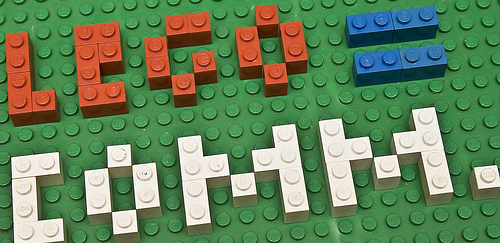
I’ll admit it: like Tyler, I’m a legoholic. Few things make my stomach tickle more than seeing a good custom LEGO model, or MOC (standing for My Own Creation), as those of us in the hobby call it. But really, what is it that makes a good MOC good? Is there a way to find that out?
Yes there is. And I’m going to teach you how to be a LEGO building God. Or at least how to suck just a wee bit less.
I know what you’re thinking: “Linus, come on! Good is in the eye of the beholder!” and  “Good is dependant on which building style is ‘in’ at the moment!”. And you know, I agree. But if we stop looking at MOCs as pretty sculptures and look at them from a communicational point of view – analyze them as a message from an author to a viewer – we can actually see pretty interesting things. We won’t understand per se why Nannan’s wicked Black Fantasies are so fun to look at, or why Michael Jasper’s furniture is so fascinating, but we can structure our thoughts regarding them a bit better – and in the end, begin to understand why they make an impact on us.
“Good is dependant on which building style is ‘in’ at the moment!”. And you know, I agree. But if we stop looking at MOCs as pretty sculptures and look at them from a communicational point of view – analyze them as a message from an author to a viewer – we can actually see pretty interesting things. We won’t understand per se why Nannan’s wicked Black Fantasies are so fun to look at, or why Michael Jasper’s furniture is so fascinating, but we can structure our thoughts regarding them a bit better – and in the end, begin to understand why they make an impact on us.
And so, in a series of six posts starting with the next one, I’ll be outlining one way to look at how a LEGO message is constructed. I’ll start with the broader perspective, discussing contextual relations (don’t worry, it’s not as boring as it sounds) and then work my way down to the design & build, presentation, and other factors. I’ll publish the new instalment every Monday.
My goal with this series is to get you thinking. During these six weeks I hope you’ll chime in with objections, thoughts and examples in the comments section, and if that’s the case the sixth and last post will contain a summary of our discussion, links to references and other goodies on the subject. Could be fun, yeah?
Since we’re heading deeper into the serious LEGO world in these posts, it’s inevitable that I’ll use some of the lingo the LEGO community has created. I will explain the stranger words as they come up, but don’t be afraid to ask about a term you don’t understand or let me know when I do it too much. All of them are in this LEGO acronym guide too if worst comes to worst, but as said, let me know.
All of these posts are mainly based on my own experience and knowledge, of which you can read more on my about page. This type of series is also a first for the Brothers Brick, so don’t be afraid to voice your opinion about that too. And while we’re at it, feel free to give me a holla’ regarding grammer and speling too.
Phew, I think that’s all of it.
Now, let’s get to it, shall we? Tomorrow we’ll start with the the most important part of it all: the context. Dun-dun-duuuun.
This post is part in a series of six discussing LEGO models from a communicational point of view, updated every Monday. Here are the other instalments:
0. Introduction
1. Context: the message
2. Context: the audience
3. Tools: Design & build, with case study #1
3b. Case study #2
3c. Case study #3
4. Tools: Presentation
5. Other
6. Summing up
This is a fantastic idea, and I’m eager to read all you’ve got. BRING IT!
Looking forward to the series, Linus. It’s always nice to have new resources, and sometimes theory can be as much fun as practice.
I’ve only lurked here before and never commented before, but I am very interested in this series and look forward to the rest as a wanna be good MOC builder. Thanks Brother’s Brick for such consistent and good food for my Lego cravings. Ok, I’ll go lurk some more.
:D I cant wait.
Hi Linus,
I’m eagerly waiting to read this serie of articles.
While waiting, TBB’s readers might be happy to read the serie of articles about the Gestalt theory applied to LEGO creation here :
http://www.mechahub.com/index.php?Itemid=167&id=70&option=com_content&task=view
Pingback: LEGO Blog: The Brothers Brick » Blog Archive » Lego is communication: context
Pingback: LEGO Blog: The Brothers Brick » Blog Archive » Lego is communication: think about your audience
Pingback: LEGO Blog: The Brothers Brick » Blog Archive » Lego is communication: design and build
grammar, not grammer
Pingback: LEGO Blog: The Brothers Brick » Blog Archive » Case study #3: “But I don’t build like you say I should!”
Deathdog: And spelling, not speling. Glad you caught the joke ;-)
Pingback: LEGO Blog: The Brothers Brick » Blog Archive » Lego is communication: Presentation
Pingback: LEGO is communication: other | The Brothers Brick | LEGO Blog
Pingback: Lego is communication: summing up | The Brothers Brick | LEGO Blog